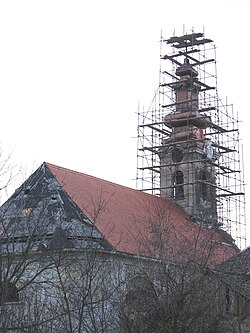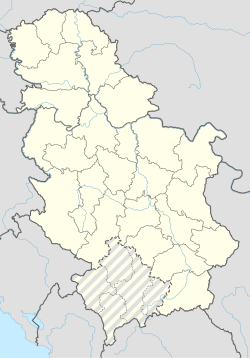Savino Selo
Savino Selo - Torschau (Torszà / Torša)
Савино Село | |
|---|---|
Village | |
 The former Protestant Church, now Serbian Orthodox. | |
| Coordinates: 45°30′N 19°31′E / 45.500°N 19.517°E | |
| Country | |
| Province | |
| Time zone | UTC+1 (CET) |
| • Summer (DST) | UTC+2 (CEST) |
Savino Selo (Serbian Cyrillic: Савино Село), formerly Torschau, is a village in Serbia. It is situated in the municipality of Vrbas, in the South Bačka District, Vojvodina province.
History
A settlement named Torsza was first mentioned in 1486. After the Turkish siege had been ended by the late 17th century, the Bačka was widely deserted. During the reign of Emperor Josef II it was being repopulated by mostly Rhinehessian Protestant families, pejoratively called Švabo (Danube Swabians) by their Serbian and Slovakian neighbours. The village of Torschau (Hungarian Torszà, Serbian Torža) was built in 1784 by these German Protestant settlers, the first of seven newly founded German villages in the Batschka. 20 other German villages were restored and resettled. [1] [2] Over the years the village became ethnically mixed; until 1945 with a mainly German plus Serbian, Slovakian and Hungarian population. In 1934 a monument was erected in remembrance of the village's 150 year long history. The Reformed Protestant church has recently been reconstructed into a Serbian Orthodox church.
Savino Selo literally means "Sava's Village", and is today named afterMontenegrinPartisan commander and so called "war hero" Sava Kovačević. During WWII, the male German population was (often forcefully) recruited by the Hungarian and later the German Armies and even the SS. There, they were turned against the Serbian population. [3] In 1944, during the last months of WWII, Torschau's German population, threatened by partisans and approaching Red Army units, was forced to flee, mainly to Hungary, Austria and Germany. Those who could not flee, such as old people, women and children, were interred in a camp in the village. There, they were starved, raped and otherwise mistreated. Many died as a result. [4] The survivors were exiled during the following years.[5] No restitutions were ever made. By 1947/48, Torschau's German population, about 3200 out of 3800 people, was gone. Instead, from 1945, partisans and settlers from Bosnia and Montenegro took over the village, forming the current ethnic structure. [6][7][8]
Ethnic groups today
According to the 2002 census, ethnic groups in the village include:
- 1,280 (38.20%) Montenegrins
- 1,211 (36.14%) Serbs
- 166 (4.95%) Slovaks
- 161 (4.81%) Hungarians
- 106 (3.16%) Croats
- others.
Population after WWII
- 1961: 5,144
- 1971: 4,044
- 1981: 3,749
- 1991: 3,767
See also
References
- ^ https://privat.genealogy.net/flacker/josans.htm/
- ^ https://www.sulinet.hu/oroksegtar/data/magyarorszagi_nemzetisegek/nemetek/die_donauschwaben/pages/008_Deutsche_Siedlungsgebiete.htm/
- ^ http://doku.zentrum-gegen-vertreibung.de/archiv/frameset05.htm/
- ^ http://www.swabiantrek.com/?page_id=504/
- ^ http://doku.zentrum-gegen-vertreibung.de/archiv/frameset05.htm/
- ^ https://www.nasemesto.rs/2017/08/04/vremeplov-kolonizacija-savinog-sela-odakle-su-stigle-porodice/
- ^ http://www.novosti.rs/vesti/naslovna/reportaze/aktuelno.293.html:474966-Bermudski-trougao-u-Backoj
- ^ https://www.danas.rs/drustvo/treca-generacija-gorstaka-iz-ravnice/
- Slobodan Ćurčić, Broj stanovnika Vojvodine, Novi Sad, 1996.
- de:Donauschwaben
- Danube Swabians
- http://www.swabiantrek.com/?page_id=504
Gallery
-
The Reformed Protestant Church.
-
The steeple of the Reformed Protestant church.
-
Monument in the village, commemorating German settlement.
45°30′N 19°31′E / 45.500°N 19.517°E




